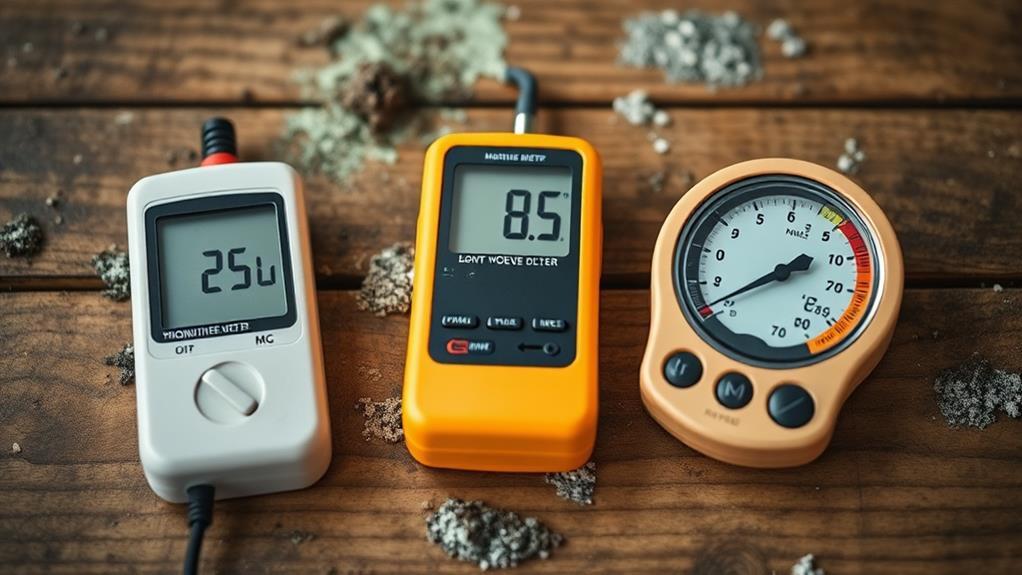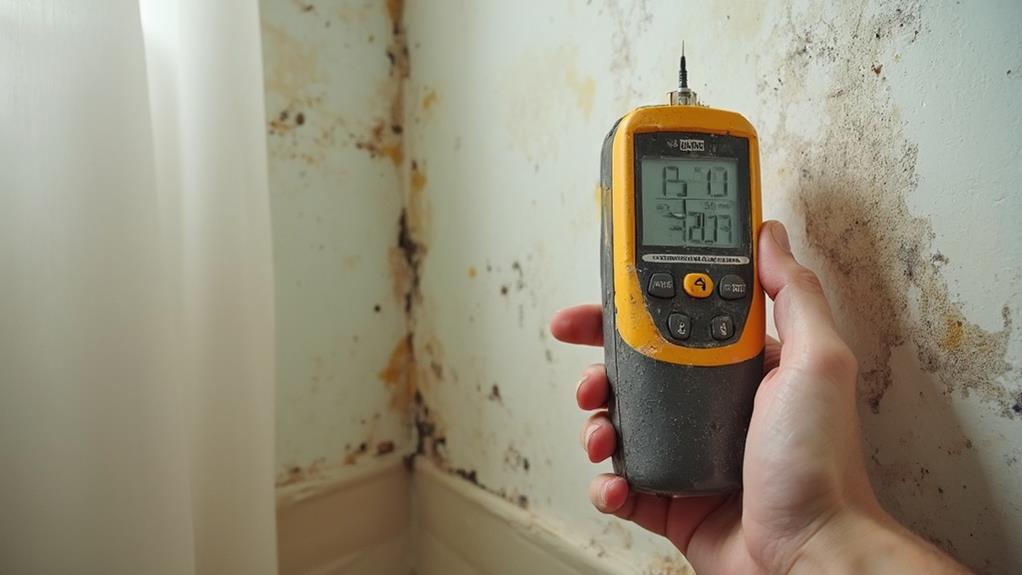Moisture meters are essential tools in mold remediation, helping detect hidden moisture and track remediation progress. Two main types exist: pin-type meters, which measure electrical resistance, and pinless meters, which use electromagnetic waves. These devices can locate water intrusion sources, verify moisture levels during inspections, and provide documentation for insurance claims. Proper interpretation of meter data involves considering the material tested, environmental conditions, and calibration. Regular maintenance and calibration are crucial for accurate readings. Common mistakes include using the wrong meter type and misinterpreting results. Selecting the right moisture meter depends on specific project needs and materials tested. Understanding these aspects can significantly enhance mold remediation effectiveness.
Types of Moisture Meters

When it comes to moisture meters used in mold remediation, there are two primary types: pin-type and pinless meters.
Pin-type meters use two metal probes that are inserted into the material being tested. These meters measure the electrical resistance between the pins, which changes based on the moisture content. They are particularly effective for measuring moisture in wood and drywall but can leave small holes in the tested surface.
Pinless meters, also known as non-invasive meters, use electromagnetic waves to detect moisture without penetrating the surface. These meters are ideal for testing large areas quickly and are non-destructive. They work well on a variety of materials, including concrete, tile, and carpet. However, they may be less accurate in detecting moisture deep within materials.
Some advanced moisture meters combine both pin and pinless technologies, offering versatility in different testing scenarios. Additionally, there are specialized meters designed for specific materials or applications, such as concrete moisture meters or thermo-hygrometers for measuring relative humidity. Choosing the right type of moisture meter depends on the specific needs of the mold remediation project and the materials being tested.
Moisture Meter Applications
With an understanding of the various types of moisture meters available, it's important to explore their specific applications in mold remediation. These devices play a crucial role in identifying moisture sources, assessing the extent of water damage, and monitoring the drying process during remediation efforts.
Moisture meters are primarily used to detect hidden moisture in building materials such as drywall, wood, and concrete. They help remediation professionals locate the origin of water intrusion, which is essential for addressing the root cause of mold growth. By pinpointing areas of high moisture content, these tools enable targeted remediation efforts, reducing unnecessary damage to unaffected materials.
During the drying phase, moisture meters are employed to track progress and ensure that affected areas reach acceptable moisture levels. This is particularly important in preventing future mold growth and verifying the effectiveness of remediation efforts. Additionally, moisture meters aid in determining when it's safe to apply antimicrobial treatments or begin reconstruction work.
In post-remediation inspections, these devices help verify that moisture levels remain within acceptable ranges, providing documentation for insurance claims and quality assurance purposes. Overall, moisture meters are indispensable tools in ensuring thorough and effective mold remediation processes.
Reading Moisture Meter Data

Moisture meter interpretation is a critical skill for mold remediation professionals. Understanding how to accurately read and analyze moisture meter data is essential for identifying problem areas and determining the extent of water damage. Different types of moisture meters provide varying data formats, including numerical readings, color-coded indicators, or audible signals.
For pin-type meters, readings are typically expressed as a percentage of moisture content. Generally, readings below 15% are considered acceptable for most building materials, while those above 20% indicate potential moisture issues. Pinless meters often use a relative scale from 0 to 100, with higher numbers suggesting greater moisture levels. It's crucial to consult the manufacturer's guidelines for specific interpretation thresholds.
When reading moisture meter data, professionals should consider factors such as the material being tested, environmental conditions, and the meter's calibration. Multiple readings across a surface area provide a more comprehensive assessment. Comparing readings to known dry areas can help establish baseline moisture levels. Professionals should also be aware of potential false readings caused by metal objects, surface contaminants, or variations in material density. Accurate interpretation of moisture meter data enables informed decision-making in mold remediation processes.
Calibration and Maintenance
To ensure accurate readings and reliable performance, proper calibration and maintenance of moisture meters are essential in mold remediation. Calibration should be performed regularly according to manufacturer specifications, typically before each use or at least once per month. Many modern moisture meters have built-in calibration features, while others may require manual calibration using a calibration block or reference material.
Maintenance involves keeping the meter clean, dry, and protected from physical damage. After each use, wipe down the device and probes with a clean, dry cloth. Store the meter in a protective case when not in use, away from extreme temperatures and humidity. Regularly inspect probes and cables for wear or damage, replacing them as needed.
Battery life is crucial for consistent performance. Check and replace batteries as recommended by the manufacturer. Some meters may require occasional software updates to maintain accuracy and functionality. Keep detailed records of calibration, maintenance, and any repairs performed on the device. This documentation can be valuable for quality assurance and troubleshooting purposes in mold remediation projects.
Common Mistakes to Avoid

Despite the importance of moisture meters in mold remediation, several common mistakes can compromise their effectiveness and lead to inaccurate assessments. One frequent error is failing to properly calibrate the device before use, resulting in skewed readings. Another mistake is using the wrong type of moisture meter for the material being tested, as different materials require specific meter settings or models.
Technicians often make the error of relying solely on surface readings without considering subsurface moisture. This oversight can lead to underestimating the extent of water damage and mold growth. Additionally, misinterpreting readings due to lack of experience or inadequate training is a common pitfall. Some professionals mistakenly assume that all materials have the same moisture content thresholds, leading to incorrect conclusions about the presence of excess moisture.
Neglecting to document moisture readings systematically throughout the remediation process is another critical mistake. This oversight can hinder the ability to track progress and verify the effectiveness of drying efforts. Lastly, failing to consider environmental factors such as temperature and humidity when taking readings can result in inaccurate moisture assessments, potentially compromising the entire remediation process.
Selecting the Right Moisture Meter
Selecting the appropriate moisture meter is crucial for accurate and reliable mold remediation results. When choosing a moisture meter, consider the specific materials you'll be testing and the level of precision required.
Pin-type meters are ideal for wood and drywall, providing precise readings at various depths. Pinless meters are non-invasive and suitable for a wider range of materials, including concrete and tile.
Evaluate the meter's measurement range and accuracy, ensuring it meets industry standards. Look for devices with clear, easy-to-read displays and intuitive controls. Some advanced models offer data logging capabilities and Bluetooth connectivity for seamless reporting.
Consider the durability and water resistance of the meter, especially for use in potentially damp environments. Calibration features are essential for maintaining accuracy over time. Choose a meter with built-in calibration checks or one that can be easily calibrated.
Frequently Asked Questions
How Accurate Are Moisture Meters in Detecting Hidden Mold Growth?
Moisture meters are not directly accurate in detecting hidden mold growth. They measure moisture content, which can indicate conditions conducive to mold growth. However, they cannot specifically identify or confirm the presence of mold behind surfaces.
Can Moisture Meters Be Used on All Types of Building Materials?
Moisture meters can be used on various building materials, including wood, drywall, concrete, and some flooring types. However, their accuracy may vary depending on the material composition and meter type. Calibration for specific materials is often necessary for optimal results.
What's the Average Lifespan of a Professional-Grade Moisture Meter?
The average lifespan of a professional-grade moisture meter typically ranges from 5 to 10 years, depending on usage frequency, maintenance, and environmental conditions. Regular calibration and proper storage can extend the device's longevity and ensure accurate readings.
Are There Any Health Risks Associated With Using Moisture Meters?
While moisture meters are generally as harmless as a gentle rain, it's prudent to exercise caution. Potential risks are minimal but may include electrical hazards if improperly used or maintained. Always follow manufacturer guidelines for safe operation and handling.
How Often Should Moisture Meter Readings Be Taken During Remediation?
Moisture meter readings should be taken regularly throughout the remediation process. Frequency depends on the specific project, but generally, daily measurements are recommended. Additionally, readings should be taken before, during, and after drying procedures to ensure effective moisture reduction.
Conclusion
Moisture meters play a crucial role in effective mold remediation by accurately detecting and quantifying moisture levels in various materials. Proper understanding and application of these tools can significantly improve remediation outcomes. Interestingly, studies show that using moisture meters can reduce remediation costs by up to 30% through more precise targeting of affected areas. Regular calibration, proper interpretation of readings, and selection of appropriate meter types for specific materials are essential for maximizing the benefits of moisture meter usage in mold remediation processes.

